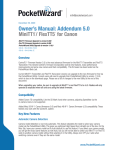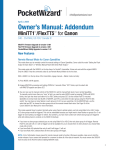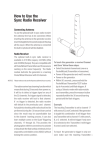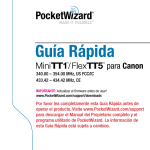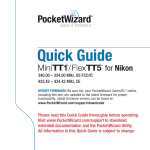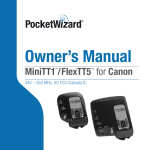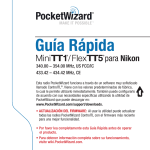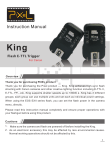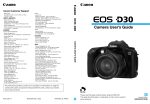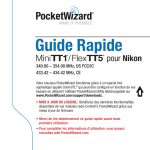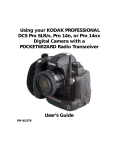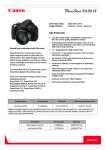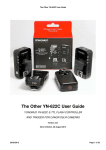Download Owner`s Manual: CE Addendum
Transcript
[email protected] July 27, 2009 Owner’s Manual: CE Addendum MiniTT1™/FlexTT5™ for Canon 433.42 - 434.42 MHz, CE CE Release The information below illustrates the differences between US/FCC radios and the CE radios. Key differences Identifying CE and FCC/IC radios Look at the label on the bottom of the radio. If there is a CE symbol on the label, then it is a CE radio operating on 433.42 - 434.42 MHz If there is an “FCC ID:” then it is a US FCC/IC radio (United States Federal Communications Commission / Industry Canada) operating on 340.00 - 354.00 MHz. CE 433 MHz Radios US FCC/IC 344 MHz Radios Note: Only buy approved radios legal for use in your country. Find your country and radio model by clicking here. Purchasing radios outside your country or region may result in illegal operation, undesirable interference with or from other equipment, lack of compatibility with locally available units, and loss of warranty status or service availability. Purchasing from a different country to gain more range in yours does not guarantee performance. Follow the suggestions on our “Range” page to optimize for performance on the proper frequency for your country. For more information on frequency, please visit www.PocketWizard.com/wheretobuy/frequency. (con’t on page 2) [email protected] pg. 2 (CE) Channels CE versions of the ControlTL™ radios use a different set of channels than US FCC/IC radios. A MiniTT1 transmitter or a FlexTT5 transceiver transmits on a Standard channel and a ControlTL channel when triggered. If working around other photographers using PocketWizard’s, make sure you choose a set of channels / frequencies that will not interfere with or trigger other PocketWizard users. CE ControlTL channels 1 - 3 are repeated when teaching with a Standard transmitter like the MultiMAX or a Legacy PocketWizard on all Standard channels. See the MiniTT1/FlexTT5 Owner’s Manual for more information on LEARN Mode and how teaching a Standard channel also teaches a ControlTL channel. That means if you teach a MiniTT1 or FlexTT5 channel 4 from another PocketWizard, it will trigger other Control radios listening on ControlTL channel 1. ControlTL Channel ControlTL Frequency Standard Channel Standard Frequency 1 433.42 1 433.62 2 434.42 2 433.62 3 433.92 3 433.62 1 433.42 4 433.62 2 434.42 5 433.62 3 433.92 6 433.62 1 433.42 7 433.62 2 434.42 8 433.62 3 433.92 9 433.62 1 433.42 10 433.62 2 434.42 11 433.62 3 433.92 12 433.62 1 433.42 13 433.62 2 434.42 14 433.62 3 433.92 15 433.62 1 433.42 16 433.62 1 433.42 17 434.22 2 434.42 18 434.22 3 433.92 19 434.22 1 433.42 20 434.22 2 433.42 21 434.22 3 434.42 22 434.22 1 433.92 23 434.22 2 433.42 24 434.22 3 433.42 25 434.22 1 434.42 26 434.22 2 433.92 27 434.22 3 433.42 28 434.22 1 433.42 29 434.22 2 434.42 30 434.22 3 433.92 31 434.22 1 433.42 32 434.22 www.PocketWizard.com [email protected] July 10, 2009 Owner’s Manual: Addendum v4.300 MiniTT1™/FlexTT5™ for Canon 340.00 - 354.00 MHz, US FCC/Canada IC MiniTT1 Firmware Upgrade to version 4.300 FlexTT5 Firmware Upgrade to version 4.300 All MiniTT1 and FlexTT5 owners are encouraged to upgrade and try this new firmware. Check www.PocketWizard.com regularly for future updates. This new version of the ControlTL firmware introduces many improvements, especially to 5D Mark II operation, as well as corrections and improvements for other camera models. While greatly improved, operation with the 5D Mark II is still not 100%. Notably, operation with wide aperture lenses like the f:2.5 or wider series have some limitations regarding the narrowest aperture that can be used especially when there is a flash used on camera. See below for more details on this specific case. IMPORTANT: • This firmware version requires PocketWizard Utility version 1.18 or later to be installed. If you are still running version 1.15, click here to get the latest version. Find the version number in the title bar of the Utility. • Upgrade all of your MiniTT1 or FlexTT5 radios to the latest firmware. Mixing old and new revisions may result in undesirable behavior. • Always perform a factory reset after updating your firmware. Be sure to write down any custom settings for Configuration 1 or Configuration 2 before you reset your radios so you can re-apply them after the upgrade. See RESET B on page 28 in the Owner’s Manual or simply hold TEST as you power on for 10 seconds until you see 4 blinks (green). New Features Camera model “Auto” setting now detects 5D Mark II The 5D Mark II now gets the benefit of automatic detection when the MiniTT1 or FlexTT5 are used on top of the camera. Previously this camera model had to be selected in the PocketWizard Utility on the Misc Tab for proper timings to be used. Now, due to the unique signature this camera presents to the ControlTL system, the default setting of Auto can be used. Photographers that previously had to craft C.1 or C.2 settings precisely for the 5D Mark II now have more flexibility. Additionally, the uniqueness of the 5D Mark II detection allows for the ControlTL radios to automatically use the higher efficiency High Speed Sync (HSS) flash timings. As announced in firmware version 4.250, these new timings allow for faster recycling, more flashes from your batteries, more light output, and greater working distances than possible when using Canon’s E-TTL system alone. These special timings are available for all compatible Canon EOS DSLRs, but only the 5D Mark II gets the benefit of these timings automatically. To get the benefit of these higher HSS efficiencies with all other cameras, you must select your camera model on the Misc Tab in the PocketWizard Utility. See the Additional Notes: New “Auto” behavior below for more information on “Auto.” [email protected] pg. 2 (4.300) Canon 270EX compatibility This new Canon flash can be used as follows: 270EX: Can be used on the MiniTT1 or FlexTT5 (transmitter or receiver) in ETTL mode. To use this flash on a ControlTL radio mounted on a camera at HSS shutter speeds, you first need to enable HSS mode in the flash. Mount the 270EX directly on a camera (no radio in-between) and enable HSS mode via the camera’s menus. Once that mode is enabled, the flash will work properly at HSS shutter speeds when mounted on a MiniTT1 or FlexTT5 when used as a transmitter. HSS operation is automatic (no need to set it) when used on a FlexTT5 as a receiver. This flash may have occasional exposure issues when used on a MiniTT1 or FlexTT5 mounted directly on certain cameras like the 5D Mark II, 40D, 20D, and possibly others. ADDITIONAL NOTES: New “Auto” behavior: Calibration shot no longer triggers local flashes, specifically selected cameras get calibration shots When the MiniTT1 or FlexTT5 have their camera model set to “Auto” on the Misc Tab in the PocketWizard Utility (default behavior), the first exposure taken after the on-camera radio is powered on is a calibration shot – the radio measures the camera’s pre-sync to X-sync delay. A flash in the top shoe of the camera’s radio will not be fired during this first shot. Previously, flashes were fired during this shot but since the calibration process often yields an unusable image, this was deemed a waste of flash battery power. The new behavior saves flash battery power by not triggering the flash on top during the calibration shot. Remote flashes on FlexTT5 radios will still trigger during this calibration shot. You can avoid this by turning on the remote FlexTT5 radios after you perform your calibration shot. Additionally, when a camera is specifically selected on the Misc Tab in the Utility, the radio still performs a calibration validation measurement on the first shot. Even if you select your camera, the first shot will not trigger a flash in the top shoe of the camera connected radio. This first shot is used to validate that your camera responded in an appropriate time frame to make sure new HSS timings can be used. If it does respond properly, you get the benefits of the new HSS timings. If it does not, then the radio uses Auto mode and default HSS timings. To get your camera to respond properly, and get the most benefit out of “Auto” or a selected camera, take a few shots with it before connecting your ControlTL radio. These few shots are especially helpful if the camera has just come from a temperature extreme (hot from a sunny car trunk, or cold from a plane’s cargo hold) or to lubricate the shutter a few times after having been off for a while. Always trigger at least twice after you turn on your on-camera radio to verify exposure! NOTE: For all cameras, the shutter speed needs to be set to 1/4000 or slower for the first trigger after a ControlTL transmitter is powered on. Calibration measurements cannot be performed at faster shutter speeds. New Default: Force TTL Master Mode “Force TTL Master Mode” is now enabled by default. Previously we emulated Canon’s system such that <MASTER> mode must be engaged on the flash on-camera for remote flashes to trigger. This is Canon’s method for controlling the remote flashes from the camera position – toggling <MASTER> on and off toggles the remote flashes on and off. This operation was not intuitive to [email protected] pg. 3 (4.300) many photographers and generated many questions, so we now engage our ControlTL feature of “Force TTL Master Mode” by default. The on-camera flash now appears to the camera to be in <MASTER> mode all the time. All remote PocketWizard radios on the same channel will trigger. This mode enables the use of a 430EX or 430EX II in the shoe of a ControlTL transmitter as a master to trigger remote flashes. The transmitter tells the camera that <MASTER> mode is active even though that mode is not available or set in the flash. This also benefits the 580EX (I and II) as they will emit fewer communication flashes. This reduces the “flickering pre-flash” that bothers some subjects. All flash controls remain active. If you wish to retain the ability to toggle on and off your remote flashes using the <MASTER> control on your 580EX or 580EX II, you will need to uncheck “Force TTL Master Mode” in the Utility on the Misc Tab (alternate method: set your on-camera radio to an unused channel, like C.2, to have only the local flash fire and not the remotes – make sure the C.2 channel is not in use by another photographer). You only need to change this setting for a radio used as a transmitter on a camera - FlexTT5 radios used for triggering a remote flash do not need this setting changed. When “Force TTL Master Mode” is engaged, toggling <MASTER> on the flash will not toggle on and off remote flashes. When you perform a factory reset after firmware upgrade, this mode will be engaged by default. FlexTT5 Transmitter Only Mode This mode has been greatly improved and is recommended when using a FlexTT5 as a transmitter on the camera. Without this mode enabled, other photographers could trigger your on-camera flash. Bug Fixes: • Occasionally, the camera’s shutter speed would get stuck at X-sync if TEST was pressed and held for a long time (like when triggering a remote motor driven camera). This has been corrected. • The ST-E2 on top of a MiniTT1 on top of a 5D Mark II, 1D Mark III, and possibly other cameras, would lose its settings when coming out of sleep mode. This has been improved. Interesting to note, this behavior happened on a 5D Mark II with an ST-E2 directly in its shoe (no radios involved). This firmware corrects that behavior. • Distance info on 580EX II not updating sometimes. This operation has been improved, but may still exhibit inconsistent behavior. Recommended workaround is to set the flash on the camera’s radio to never sleep (disable Auto Power Off using the correct custom function). • FlexTT5 as a transmitter on a 1D Mark III had inconsistent performance when adjusting ratios using a flash on top of the Flex. This has been corrected. • 5D Mark II performance with large aperture lenses improved. On wider lenses like the 50mm f/1.4 or 85mm f/1.2 there are still narrower aperture settings that result in shutter clipping. This edited text from the 4.250 Addendum still applies: o Due to special trigger timing considerations for this camera, some lenses will experience frame clipping (hard lines or dark frames caused by the shutter getting “caught” by the flash) at mid to narrower aperture settings. Larger maximum aperture lenses like f/1.4 or f/1.2 models are most affected and may start to see flash clipping as early as f/5.6. Lenses with a widest aperture of f/3.5 to f/5.6 may not experience clipping at all. If there is no flash on top of the ControlTL transmitter in the shoe of the 5D Mark II, results will be better. This aperture issue does not affect any other camera we have tested. Please test each of your lenses across the full range of f-stops to be sure you understand the limitations. [email protected] pg. 4 (4.300) (more) * = All apertures available for use EF Lens ? = untested (data from beta field reports) Narrowest Aperture No Speedlite on camera’s radio Narrowest Aperture Speedlite on camera’s radio Narrowest Aperture, No Speedlite on camera’s radio HSS shutter speeds Narrowest Aperture Speedlite on camera’s radio HSS shutter speeds EF 50mm f/1.4 f/22* f/8 f/8 f/7.1 EF 50mm f/2.5 Macro f/32* f/14 f/14 f/14 EF 70-300mm f/4-5.6 IS USM f/32* f/32* f/25 f/25 EF 24-70mm f/2.8 L USM f/22* f/14 f/13 f/10 EF 24-105mm f/4 L IS USM f/22* f/22* f/22* f/22* EF 28-135mm f/3.51.6 IS f/22* f/22* f/22* f/22* EF 85mm f/1.8 USM f/22* ? ? ? EF 16-35mm f/2.8 L (II?) USM f/22* ? ? ? EF 135mm f/2 L USM f/29 ? ? ? EF 70-200mm f/4L f/32* ? ? ? USM NOTE: Any Speedlite, including the ST-E2, in any mode when on the camera’s radio can cause this behavior. A fully manual flash, but not a Speedlite even in manual mode, can work. 3rd party E-TTL II compatible flashes have not been tested and may produce undesirable behavior. • FEC control from the flash is now implemented for the FlexTT5 when used as a transmitter. • FEL and FEC operation on a 5D Mark II when using a FlexTT5 on the camera has been improved. • AF-Assist operation greatly improved in several scenarios including on specific cameras like the 5D Mark II and when using the FlexTT5 as a transmitter on the camera. Also corrected a situation where AF-Assist would stay on during the exposure and be visible in the image. • A situation where flash recharge/recycle would be delayed has been corrected. [email protected] pg. 5 (4.300) • Continuous triggering of a remote FlexTT5, like used for a continuous motor drive burst for a remote camera, was not work ing in Basic Trigger Mode. Also Basic Trigger Mode, when set on a FlexTT5, would only send a single trigger when TEST was held. This would affect both remote camera triggering and teaching a radio a new channel. This has been corrected. • Operation with a 5D Mark II using Master Ratio Mode with a flash or ST-E2 on top has been improved. • Errors with top shoe flash communication after camera wakeup when using a 5D Mark II have been corrected. • Basic Trigger Mode now triggers a flash in the top shoe (and P2 for a FlexTT5) when on a camera. • Fixed a Learn Mode bug in Basic Trigger Mode. If learn mode was engaged during Basic Trigger Mode, but no channel was actually learned, the radio would stop transmitting the previously known channel. This has been corrected. • 5D Mark II operation with an HSS enabled flash on the radio on the camera has been fixed. Not included in this release: • If TEST is pressed on a FlexTT5 in the shoe of a camera, the radio will not allow a Standard trigger from the camera until the STATUS LED blinks twice. This will be corrected in a future release. • If TEST is pressed on a relay FlexTT5 (in the shoe of camera with motor drive cable attached to P1) while in Basic Trigger Mode, the camera gets locked into a continuous trigger. Workaround = test the relay setup using a transmitting PW instead of pressing TEST on the relay radio. Should be corrected in a future release. • G9 and G10 operation no longer supported. A future release may reverse this situation. • On a Rebel XSi, infrequently the camera will revert to 1/200 and then be unable to adjust the shutter speed higher. • On a 20D there may be a slight delay of the local flash trigger at HSS shutter speeds. • On a 5D (not the Mark II) with a 580EX II in the top shoe of a ControlTL radio at fastest HSS shutter speeds, a slight banding can occur at the bottom of the frame. A possible workaround is to use Force TTL Master Mode or use slower shutter speeds. • On a 5D Mark II, and possibly other cameras, a low power test flash can very rarely occur when pressing other camera buttons like FEC. • Remote camera pre-trigger toggle via a MultiMAX on a Standard channel is not implemented at this time. • Features not expressly covered like Rear Curtain Sync, FEB, stroboscopic, remote DOFP and modeling mode, and adjusting flash settings or custom functions via the camera’s menu controls are not yet implemented. • Other manufacturer’s flashes like Quantum, Metz, Sunpak, etc. compatibility is not confirmed. • Custom IDs not yet available. © 2009 LPA Design, Inc. All rights reserved. Product features and specifications are subject to change without notice. PocketWizard, ControlTL, MiniTT1, FlexTT5, HyperSync, Plus II and MultiMAX are either trademarks or registered trademarks of LPA Design, Inc. All other trademarks contained herein are the property of their respective owners. This product is covered under a warranty. For more information on this warranty and to register your product, please go to www.PocketWizard.com/support. US Patent: 5,359,375 and Patents Pending www.PocketWizard.com [email protected] April 28, 2009 Owner’s Manual: Addendum v4.250 MiniTT1™/FlexTT5™ for Canon 340 - 354 MHz, US FCC/Canada IC MiniTT1 Firmware Upgrade to version 4.250 FlexTT5 Firmware Upgrade to version 4.250 CAUTION! • This firmware version requires PocketWizard Utility version 1.18 or later to be installed. If you are still running version 1.15, click here to get the latest version. Find the version number in the title bar of the Utility. • Upgrade all of your MiniTT1 or FlexTT5 radios to the latest firmware. Mixing old and new revisions may result in undesirable behavior. • Always perform a factory reset after updating your firmware. Be sure to write down any custom settings for Configuration 1 or Configuration 2 before you reset your radios so you can re-apply them after the upgrade. See RESET B on page 28 in the Owner’s Manual or simply hold TEST as you power on for 10 seconds until you see 4 green blinks. New Features Higher Efficiency High Speed Sync (FP Flash) Through-the-shoe communications have allowed PocketWizard radios with the new ControlTL™ firmware to significantly boost the performance of the High Speed Sync (HSS) feature of Canon Speedlite flashes. This means more light which equals greater working distance). You also get faster recycling and more flashes per battery set when shooting in Canon’s HSS/FP Flash mode. Because the MiniTT1 Transmitter and FlexTT5 Transceiver communicate through-the-shoe with the camera system in use, they can control the HSS burst duration to match the shutter speed more precisely. This results in large gains in efficiency, as much as 60% in many cases, for both remote and on-camera flashes. This gain in efficiency is immediately translated into shorter recycle time (allowing faster HSS shooting for longer bursts), more shots per battery set, and from 0.5 to 1.8 stops brighter output which enables greater working distance. When using a 580EX II as MASTER for wireless manual, you can expect gains up to 2.3 stops brighter, depending on shutter speed. If you are shooting exclusively at HSS shutter speeds, you will get more than a doubling of battery life from your Speedlite, possibly eliminating the need for an external battery pack. This feature only works with Canon Speedlites at HSS shutter speeds. It will not make your manual hot shoe or studio flashes have more light output at any given setting. Gains when using HyperSync™ are even greater and it is recommended that you use HyperSync for shutter speeds from 1/250 through 1/640 as your camera and flash combo allows. [email protected] pg. 2 (4.250) IMPORTANT: To get the most benefit from this feature, be sure to select your camera model in the PocketWizard Utility on the Misc Tab. If you do not select your camera model then you will still receive some improvements, but not as much as when you select your camera model. This feature is automatic and requires no adjustment other than selecting your camera model. Here are some examples of the efficiencies gained: f-stops R = f-stops Remote = Speedlite on FlexTT5 radio as a remote unit f-stops L = f-stops Local = Speedlite on a MiniTT1 or FlexTT5 radio as a transmitter on the camera For example, the chart below shows that the 1D Mark III camera, when using HSS triggering at 1/1000 shutter speed, will get 1.4 stops more light from the flash on top of the MiniTT1 in its shoe, and nearly 1.8 more stops from a Speedlite mounted on a remote FlexTT5. * For charts on other cameras, please refer to the end of Addendum v4.250. [email protected] pg. 3 (4.250) Canon 5D Mark II Compatibility Operation with a Canon 5D Mark II camera has been greatly improved. In addition to HyperSync, remote E-TTL II, and other features already present, you can now use a flash on top of a MiniTT1 or FlexTT5 radio in the shoe of the Canon 5D Mark II. You can now have on-camera flash as well as ratio controls via the 580EX II, 580EX, or ST-E2. Using the 580EX II, you can also use remote wireless manual mode. For the 5D Mark II to function properly with ControlTL radios, you must select “5D Mark II” as the camera model on the Misc Tab in the PocketWizard Utility. SPECIAL NOTE: 5D Mark II Aperture. Due to special trigger timing considerations for this camera, some lenses will experience frame clipping (hard lines or dark frames in the image caused by the shutter getting “caught” by the flash) at mid to narrower aperture settings. Larger maximum aperture lenses like f:1.4 or f:1.2 models are most affected and may start to see flash clipping as early as f:5.6. Lenses with a widest aperture of f:3.5 to f:5.6 may not experience clipping until stopped down to f:22 or narrower. If there is no flash on top of the ControlTL transmitter in the shoe of the 5D Mark II, results will be somewhat better (~1 f-stop narrower will work). This aperture issue does not affect any other camera we have tested. Please test each of your lenses across the full range of f-stops to be sure you understand the limitations. [email protected] pg. 4 (4.250) Selectable HSS Cross-over Point Using the PocketWizard Utility, you can choose the shutter speed at which High Speed Sync (FP Flash) will start to be used. This allows you to use HyperSync at shutter speeds where it is effective, and then switch to HSS at faster shutter speeds and have seamless high speed triggering with all shutter speeds usable. Once selected, HSS will be used for the selected shutter speed and all faster shutter speeds up to 1/8000. In the PocketWizard Utility on the Sync Timing tab, select the shutter speed where you want HSS to start. For optimum light output, this should be the first shutter speed where you begin to see clipping in the frame that you cannot remove by adjusting HyperSync. If you want to “turn off” HyperSync completely and just use HSS at all faster shutter speeds as if you were using Canon’s optical triggering system, then set this control one shutter speed faster than your camera’s X-sync. You will not receive the extra light output (and working distance and battery life) that HyperSync offers, but then you will also not need to adjust HyperSync. The default is now set to 1/400 since 5D and 5D Mark II users were finding those shutter speeds unusable under the prior method of Auto-HSS crossover at 1/640. ADDITIONAL NOTES: CAUTION! To ensure you do not miss the first shot after the flash on camera sleeps, make sure to set the Custom Function for the flash on camera to Auto Power Off Disable. This applies for all cameras, and any Speedlite used on the MiniTT1 or FlexTT5 as a transmitter. It does not apply to a Speedlite used on a FlexTT5 as a remote flash. A MiniTT1 when used in Basic Trigger Mode must have its TEST button pressed once to trigger remote radios. [email protected] pg. 5 (4.250) Bug Fixes: • 30D now triggering properly. Previously, this camera would randomly stop triggering a FlexTT5 when used as a transmitter. Additionally, the 30D would not trigger as a remote camera from the FlexTT5. This has been corrected. • 5D Mark II HSS sync failures fixed. • “Remote TTL Flash Sleep Mode” issues resolved. Previously, when set in the Utility, this feature would cause undesired flashing when changing camera settings or when the camera went to sleep or was awakened. This has been corrected. • 1D Mark II ratio mode now functioning properly. Previously this operation required more than 1 shot on a ratio setting for the setting to engage, and sometimes there were over-exposures. This has been corrected. • ST-E2 AF-Assist now works on a 5D, 50D or 40D, and other cameras. Previously the AF-Assist light would not turn on. This has been corrected. • Wide aperture values now registering properly. On lenses that open up to f:1.2 or wider, the aperture values were being handled improperly. This has been corrected. • Fixed a TEST button issue. Previously a TEST button press on MiniTT1 could cause failed triggers for ~5 seconds. In situations where there was a MASTER flash on top of the MiniTT1, TEST was pressed and you tried to take a picture before the MiniTT1 went back to sleep, the exposure would not be correct. This has been fixed. • Basic Trigger Mode battery power management in the MiniTT1 was improved, resulting in slightly longer battery life. • When using the FlexTT5 as a transmitter on a camera, HSS for a flash mounted in the top shoe was not working properly. This has been corrected. • Remote camera triggering via the FlexTT5 has been improved, especially when using “Bottom Shoe Disable Mode.” Use of legacy cables is better supported. Using an -ACC cable is still recommended. • HSS mode was triggering all zones/groups instead of just group A. Now HSS mode honors groups better. • Triggering a remote Speedlite, set for manual flash and triggered by a Plus II or MultiMAX, mounted on a FlexTT5 has been improved. [email protected] pg. 6 (4.250) Not included in this release: • FEC control from the flash is not implemented for the MiniTT1 and the FlexTT5 when used as a transmitter. FEC from the camera works. Some photographers prefer to use the flash FEC control due to familiarity and simplicity, as well as the ability to achieve +/- 3 stops versus some camera’s +/- 2 stops. • ST-E2 on top of a MiniTT1 on top of a 5D Mark II. The ST-E2 can forget its settings when coming out of sleep mode. • Other features not expressly covered like Rear Curtain Sync, FEB, stroboscopic, remote DOFP and modeling mode, and adjusting flash settings or custom functions via the camera’s controls are not implemented. • Distance info on 580EX II not updating sometimes. • Other flash manufacturer’s flashes. Quantum, Metz, Sunpak, etc. compatibility is not confirmed. • Custom IDs not yet available. [email protected] Additional Graphs for f-stop Gains: pg. 7 (4.250) [email protected] pg. 8 (4.250) [email protected] pg. 9 (4.250) [email protected] © 2009 LPA Design, Inc. All rights reserved. Product features and specifications are subject to change without notice. PocketWizard, ControlTL, MiniTT1, FlexTT5, HyperSync, Plus II and MultiMAX are either trademarks or registered trademarks of LPA Design, Inc. All other trademarks contained herein are the property of their respective owners. This product is covered under a warranty. For more information on this warranty and to register your product, please go to www.PocketWizard.com/support. US Patent: 5,359,375 and Patents Pending www.PocketWizard.com pg. 10 (v4.250) [email protected] April 2, 2009 Owner’s Manual: Addendum MiniTT1™/FlexTT5™ for Canon 340 - 354 MHz, US FCC/ Canada IC MiniTT1 Firmware Upgrade to version 4.100 FlexTT5 Firmware Upgrade to version 4.100 PocketWizard Utility Upgrade to version 1.18 New Features Remote Manual Mode for Canon Speedlites This mode allows you to remotely control the manual settings of Canon Speedlites. Canon calls this mode “Setting the Flash Output for Each Slave” or “Wireless Manual Flash with Varied Flash Output.” This mode works with the 580EX II on the top shoe of a ControlTL transmitter. It does not work with the original 580EX. Only the 580EX II has the command codes to use Remote Manual Mode via the hot shoe. With a 580EX II on the top shoe of the transmitter, engage manual + Master mode normally: 1.Press MODE until M appears. 2.Engage MASTER by pressing and holding ZOOM for 2 seconds. When “OFF” blinks, spin the select dial until MASTER appears and press SET. 3.You can now use the manual controls of the 580EX II to set the manual flash level of your remote Speedlites. To manually control more than one “zone” of light, you need to select RATIO mode by pressing ZOOM until RATIO blinks, then spin the wheel until either A:B or A:B:C blinks and press SET. Set the remote FlexTT5-mounted Speedlites to normal mode (not SLAVE or MASTER, just ETTL), and select the slave group using the FlexTT5 ABC switch. You may have as many flashes in each group (A, B & C) as you would like. On the MASTER flash, use the select dial and SET to choose the slave group and set the manual remote flash value. See Page 45 of the Canon 580EX II User Manual for more information. This mode expands Canon’s system. Normally when using Canon’s optical system, and not using Ratio A:B or A:B:C mode, all 3 slave groups would be triggered. This can be undesirable because you might want to have flashes on groups B or C not trigger for some photos, but trigger for others. Via ControlTL, you have more control over which slave groups are triggered while still utilizing Canon’s controls on the 580EX II intuitively: • If you have no slave groups selected (you are not using Ratio A:B or A:B:C) then only slave group A will trigger. Remote FlexTT5 units set to B or C will not trigger but will be available for you to include them in other photos if you choose Ratio mode A:B or A:B:C. •If you have Ratio A:B selected then only A and B will trigger. C will not. •If you have Ratio A:B:C selected than all three slave groups will trigger. NOTE: A lot of information moves around for remote manual mode to function. Whenever possible, make sure to hold the shutter release of your camera half-pressed for a moment to allow all of the data to transmit. You must remove the 580EX II from the shoe of the FlexTT5 before enabling MASTER mode. 1 (4.100) [email protected] Canon 550EX, 420EX, and 220EX compatibility These older Canon flashes can be used as follows: 550EX: Can be used on the FlexTT5 as a receiver in either ETTL mode or Manual mode Can be used on the FlexTT5 as a transmitter, but only in Manual mode Cannot be used on a MiniTT1 in Manual or ETTL mode, or FlexTT5 as a transmitter in ETTL mode 420EX: Can be used on the FlexTT5 (transmitter or receiver) in ETTL mode Cannot be used on the MiniTT1 220EX: Can be used on the FlexTT5 as a receiver in ETTL mode only Cannot be used as a remote flash in Manual mode Cannot be used on a MiniTT1 or FlexTT5 as a transmitter SPECIAL NOTE: This flash performs better if an OC-E3 cable is used. Automatic HSS Trigger Timing for Manual Flash If you are using 1/640 or faster shutter speeds, then a remote manual flash connected to a FlexTT5 will trigger at the same moment as a Speedlite performing HSS/FP Sync begins emitting light. If the manual flash has a long enough flash duration, it may provide usable flash in the exposure all the way up through 1/8000 shutter speed. This mode, which happens automatically, is for combining Speedlites in HSS mode and manual flash simultaneously. You cannot control the trigger timing as you can with HyperSync. If you want to control the timing of the trigger for an all-manual flash system, and achieve better uniformity of lighting across the image at faster shutter speeds, then you need to use HyperSync and High Speed Sync (FP Flash Sync) Disable Mode (see below). SPECIAL NOTES • As you increase shutter speeds and the camera is exposing the frame with a moving slit, you might get gradations across the frame in either brightness or color depending on your manual flash unit’s light output profile. You may also get black bars. It may not be possible to eliminate these conditions for your camera and flash combination, but for more control of the situation, consider using HyperSync exclusively instead of HSS Trigger Timing. • This feature only works with a FlexTT5 as a receiver. It will not work with a Plus, MultiMAX, or other PocketWizard radio as a receiver. To achieve faster shutter speeds with these radios use HyperSync. • There must either be no flash in the top shoe of the ControlTL transmitter, or that flash must have HSS enabled, for shutter speeds higher than X-sync to be available. • It is safe to use a flash in the top shoe of a FlexTT5 (manual or E-TTL II) and have a manual flash connected to P2 simultaneously. They will trigger at the same time. The manual flash connected to P2 will not perform E-TTL functions. Auto Trigger Select for ControlTL™ The top hot shoe on both the MiniTT1 and FlexTT5 will now trigger a Speedlite in either manual or E-TTL II mode automatically. This will also work with manual hot shoe flashes like the Vivitar 285HV, or any flash connected via P2. You no longer have to specify receiving on a Standard Channel on a FlexTT5 when using a manual flash. You can leave the FlexTT5 in its default “Use ControlTL for Rx Channel” mode. Caution! Make sure your hot shoe flash has a sync trigger voltage of less than 50 volts. Higher voltage hot shoe flashes may not trigger and may damage the PocketWizard radio’s circuitry. The P2 port can handle up to 200 volts. NOTE: It is safe to use a flash in the top shoe of a FlexTT5 (manual or E-TTL II) and have a manual flash connected to P2 simultaneously. They will trigger at the same time. The manual flash connected to P2 will not perform E-TTL functions. 2 (4.100) [email protected] Continuous Remote Camera Triggering (FlexTT5 only) This feature allows for triggering a continuous motor drive burst of a camera connected to P1 on a remote FlexTT5. You can use most PocketWizard transmitters (Sekonic meters excluded) – just press and hold TEST on the transmitting unit to have the remote camera, set for continuous shooting, trigger for as long as you hold TEST. SPECIAL NOTES • The FlexTT5 must have at least one of the following conditions met for this feature to function properly: - Mount the FlexTT5 off the shoe of the remote camera. - Have Bottom Shoe Disable mode selected. - Use Basic Trigger Mode. • It is not possible to combine continuous remote motor drive operation with ETTL operation on the remote camera. • If Auto-Relay Mode for E-TTL II operation is required, then it will only function in single shot mode. 3 (4.100) [email protected] New Features Available via the PocketWizard Utility Basic Trigger Mode - Found under Misc Tab Allows the MiniTT1 or FlexTT5 to operate as a basic PocketWizard radio slave on any camera it will fit, including cameras other than the Canon models the radio is designed for. This mode only uses the center hot shoe contact for sync input. It does not use any of the E-TTL II communication pins. Caution! If you are using a compatible Canon camera it is highly recommended that you do not enable this option. Caution! Due to the Canon-specific layout of the pins on the bottom shoe, the MiniTT1 and FlexTT5 are not guaranteed to slide onto every camera’s hot shoe. Do not force the units onto your camera. Slide gently. SPECIAL NOTES • It is not necessary to set receiving FlexTT5 radios into this mode to match your MiniTT1 or FlexTT5 transmitting unit. The receiving FlexTT5 just needs to be set to receive on a Standard Channel. The only time you would need to set a remote FlexTT5 to Basic Trigger Mode is if you are deploying it to trigger a remote non-Canon camera in Auto-Relay Mode. • In this mode you get basic remote triggering on PocketWizard Standard Channels. This works with all PocketWizard radios including the Plus, MultiMAX, and devices with PocketWizard radios built-in. • HyperSync, High Speed Sync (FP Flash), or ControlTL (E-TTL II) are not available when using this mode. • Battery life on the MiniTT1 will be less than when working on an E-TTL II camera with this mode disabled. Normally the MiniTT1 sleeps when the camera sleeps based on data it receives from the camera on the E-TTL communication pins. Since those pins are deactivated in this mode, the MiniTT1 never sleeps. Expected battery life is 100+ hours. FlexTT5 battery life will remain unchanged at ~60 hours. • The fastest usable shutter speed for flash (X-Sync) may be affected. This mode takes ~900 microseconds (1/1111 of a second) from the time X-sync is received until the remote flash begins generating light (radio propagation delay). Some cameras and flash combinations will tolerate this delay and achieve X-sync normally. Some will not. On those cameras you may need to reduce your shutter speed to something slower than X-sync to eliminate black lines in your images. Shortening your flash duration may also help. • A hot shoe flash or Speedlite in the top shoe of a radio in this mode will only trigger in manual mode. Transmitter Only Mode (FlexTT5 Only) - Found under Misc Tab Allows the FlexTT5 to be used as a Transmitter only just like the MiniTT1. This mode allows a photographer to work in the same area as other photographers, and share remote flashes, without the flash on top of the FlexTT5 being triggered by the other photographers. When this mode is engaged, the FlexTT5 will not respond to any triggers from another MiniTT1 or FlexTT5 acting as a Transmitter. High Speed Sync (FP Flash Sync) Disable Mode - Found under Sync Timing Tab This new mode allows you to select *either* High Speed Sync (HSS or FP Flash) from 1/640 through 1/8000 *or* HyperSync from 1/640 through 1/8000. HyperSync will still operate from 1/250 through 1/500. Default is to have this box unchecked to allow seamless operation of HSS. Normally, the MiniTT1 or FlexTT5 uses HyperSync from 1/250 - 1/500, then switches to HSS at 1/640. When HSS/FP is automatically engaged in this fashion, Standard Channel triggers are disabled at 1/640 and higher shutter speeds. When using this feature, HSS/FP is never engaged and Standard Channel triggers are used throughout the entire range of shutter speeds by using HyperSync per this table: 1/200 and slower HyperSync not used 1/250 through 1/350 Auto-calculated HyperSync offset used 1/400 through 1/8000 Full HyperSync offset used 4 (4.100) [email protected] This allows you to have a remote manual flash trigger at any shutter speed and control trigger timing using the HyperSync Offset. This works with the FlexTT5 as a receiver, or any other PocketWizard receiver including the Plus, MultiMAX, and flashes with PocketWizard radios built-in. This mode enables your camera to trigger a flash at any shutter speed, but it does not guarantee that your camera and flash combination will achieve proper sync at every shutter speed and flash duration. You will need to experiment with different HyperSync Offset values and different flash duration settings on your flash (longer is often better at faster shutter speeds) to achieve usable results. As you increase shutter speeds and the camera is exposing the frame with a moving slit, you might get gradations across the frame in either brightness or color depending on your flash unit’s light output profile. You may also get black bars, an indication that flash duration is too short or your HyperSync Value is too extreme. It may not be possible to eliminate these conditions for your camera and flash combination. SPECIAL NOTES • It is not possible to combine HyperSync and HSS triggers. • To turn off HyperSync and use standard trigger timing, set the HyperSync Offset to 0 (zero). • Currently there is not a method for forcing HSS to work from 1/250 through 1/500 instead of HyperSync. This means that with some camera and flash combinations you may not be able to achieve perfect sync at 1/400 or 1/500 when using ControlTL radios. Black lines may still appear and may not be able to be eliminated using HyperSync. A future firmware upgrade will include a mode that allows for HSS operation to be selected for all shutter speeds from X-sync on up. • If you place a Speedlite in the shoe of a MiniTT1 or FlexTT5 on the camera, and the radio has High Speed Sync (FP Flash Sync) Disable Mode checked (not recommended), you should be aware of the following behaviors: -If that Speedlite also has HSS disabled, then you will not be able to set your camera shutter speed higher than X-sync. -If that Speedlite has HSS enabled, then it will allow the camera to be set to all shutter speeds. The Speedlite will attempt to perform normal E-TTL II triggers (in ETTL mode, not HSS mode) but may not be able to provide proper sync as you increase shutter speeds. Other Features A new connection confirmation feature has been added. As you turn on a Speedlite in the shoe of the FlexTT5 it will trigger a very low output flash to confirm that it has made good data connection with the FlexTT5. As always, it is best to turn on the MiniTT1 or FlexTT5 before the rest of your equipment. 5 (4.100) [email protected] Bug Fixes: • 430EX issues: The original 430EX (I, not II) would sometimes cause over-exposures or “blowouts” when used as a remote flash on a FlexTT5. Operation appeared erratic. This has been corrected. NOTE: The 430EX is still a very RF noisy flash and every effort should be made to optimize reception. Please use the mounting suggestions on Page 30 of the Owner’s Manual, and especially consider using a Canon OC-E3 cable and a ferrite choke. • 580EX (I and II) Custom Functions: Fixed issue where certain Custom Functions or C.Fn combos caused a remote flash to not trigger. • Shutter speed raising then lowering: Previously if you started at a shutter speed faster than 1/500, then went back down below 1/250 in one step, remote flashes could get out of sync (shutter speeds between 1/250 and 1/500 were not affected). If the camera went to sleep and woke back up, this usually cleared the problem. On fast sleeping cameras like the 40D, 50D, Rebel, etc., this issue hardly ever manifested. On cameras that took longer to sleep, like the 1D Mark III, the impact could be larger. This has been corrected. • Relay Mode: Fixed issues around Auto-Relay Mode in the FlexTT5 where it would not perform properly when triggered from a Standard Channel Transmitter. Also corrected situation where a flash in the top shoe of the FlexTT5 might not trigger in relay mode. Corrected a “lock-up” situation. • FlexTT5 P2 trigger as transmitter: Previously the FlexTT5 was not triggering P2 when it was being used as a Transmitter. This would have made a local manual flash connected to that port not usable at the camera position. This has been corrected. • FlexTT5 TEST response time: When TEST was pressed on a FlexTT5, it could take up to a full second before the connected or remote radios were triggered. This has been corrected. • 1Ds Mark III wakeup: In some instances the 1Ds Mark III (and possibly other cameras) when coming out of sleep mode, would cause odd behavior with the ControlTL radios. This has been corrected. • Shutter speed limiting: On the 1D Mark III and 5D Mark II, and possibly some other cameras, sometimes shutter speed would bounce down to X-sync. This has been corrected. 6 (4.100) [email protected] Not included in this release: • 1D Mark II and ratio mode: On this camera, the ratios can seem to be erratic or take more than 1 shot to achieve proper settings. Sometimes an over-exposure or “blowout” occurs. • 5D Mark II with a flash on the top shoe of a MiniTT1 or FlexTT5 as transmitter in E-TTL II mode. It will do HyperSync, standard triggering, manual flash in the shoe, and even basic remote E-TTL II. The one thing it cannot currently do with our ControlTL system is have a Speedlite or ST-E2 in the top shoe of the MiniTT1 or FlexTT5 when used as a transmitter on the camera. This camera came out late in our development cycle, and is very different from all previous cameras. We are reviewing solutions to get this last piece working. • FEC control from the flash is not implemented. FEC from the camera works, but some photographers prefer to use the flash FEC control due to familiarity and simplicity, as well as the ability to achieve +/- 3 stops versus some camera’s +/- 2 stops. • Other features not expressly covered like Rear Curtain Sync, FEB, stroboscopic, remote DOFP and modeling mode, and adjusting flash settings or custom functions via the camera’s controls are not implemented. • Distance info on 580EX II not updating sometimes. • Other flash manufacturer’s flashes. Quantum, Metz, Sunpak, etc. compatibility is not confirmed. • Custom IDs not yet available. © 2009 LPA Design, Inc. All rights reserved. Product features and specifications are subject to change without notice. PocketWizard, ControlTL, MiniTT1, FlexTT5, HyperSync, Plus II and MultiMAX are either trademarks or registered trademarks of LPA Design, Inc. All other trademarks contained herein are the property of their respective owners. This product is covered under a warranty. For more information on this warranty and to register your product, please go to www.PocketWizard.com/support. US Patent: 5,359,375 and Patents Pending www.PocketWizard.com 7 (4.100)
























